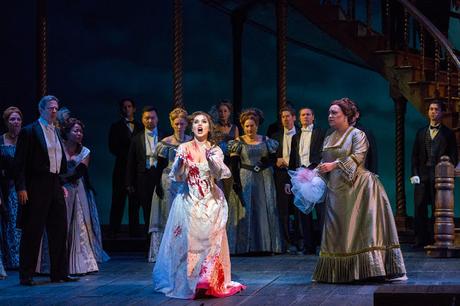by Paul J. Pelkonen

Crazy for feelin' so blue: Olga Peretyatko-Mariotti (center, covered in blood) as the bride of Lammermoor.
Photo © 2018 Richard Termine for the Metropolitan Opera. Used with permission.
On Thursday night, the Met revived its 2008 production of Lucia with Olga Peretyatko-Mariotti taking on the title role. This is the first of two Lucia casts this spring, taking the stage in Mary Zimmerman's handsome, somewhat surreal staging of the story that takes the opera back to its roots as a 19th century Gothic novel. Ghosts walk through Ms. Zimmerman's version of Scotland, and its its high, surreal castle rooms, enormous moon and dark tint remain successful and atmospheric.
Less successful was the casting of Olga Peretyatko-Mariotti in the title role. The soprano has all the right tools for this part, but Thursday night's performance found her cool and somewhat removed, marshalling all of her resources to spend them in the gigantic Mad Scene that is the climax of the opera. This made her Lucia a dull heroine for the first act, and the character's slow descent into madness seemed to take place as if under psychotropic medication. That same affliction seemed to infect the whole cast in these scenes, as the all-important exposition unrolled at leaden pace.
However, Ms. Peretyatko-Mariotti was a different creature in the second and third acts.. Starting with her big duet with Enrico (Massimo Cavalletti) her performance ignited, providing the spark that this opera needs to be more than just a collection of pretty tunes. That surge continued as she emerged for the fatal scene where Lucia signs the wedding contract that seals her fate. Against the full force of five other soloists and the Met chorus, she soared, bringing the Act II sextet to glorious life.
In the long Mad Scene, she shifted personalities with remarkable vocal athleticism, piping out the high notes and descending for the shocking, occasional moments of lucidity. Only in the last note did she run out of air as she fainted, exiting carried aloft by strong supernumeraries. This was not the end of her performance, as Ms. Zimmerman calls for Lucia to literally haunt Edgardo during his final scene, urging him to her arms to ghostly effect.
Vittorio Grigolo was robust, bold and energetic as Edgardo, if not especially tormented. This role fits the enthusiastic Italian tenor better than the heavy stuff he sang earlier in the season. Mr. Grigolo he was having a good time and taking us with him even as he hammed it up with a sword in the Act II wedding scene. Massimo Cavalletti was less successful as Enrico, Lucia's dirtbag brother. The baritone's voice has an ugly metallic quality that became grating as he puts his instrument under pressure--and that was just in the first act.
Moving on, let's talk about bass Vitalij Kowajow. Mr. Kowaljow made Raimondo an interesting and conflicted figure and his narration of Lucia's disastrous nuptial night brought chills, delivered from a wooden catwalk high above the stage. In the small supporting roles, tenors Gregory Schmidt and Mario Chang offered some promise. In the Met pit, conductor Roberto Abbado, the nephew of the great Claudio Abbado, showed that talent, unlike the curse of the Ashton family, does not always pass from one generation to the next.

